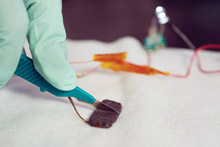A team of Stanford University, California, chemists and engineers has created what they say is the first synthetic material that is both sensitive to subtle pressure and flexion and, when torn or cut, is able to heal itself quickly and repeatedly at room temperature. The material is also a bulk conductor of electricity. The advance could lead to smarter prostheses or resilient personal electronics that self-repair. The team’s findings were published online November 11 in the journal Nature Nanotechnology.

A small piece of the self-healing material is sliced with a scalpel. The researchers say the material repairs itself in about 30 minutes. Photograph by L. A. Cicero, courtesy of Stanford University.
The researchers, led by Stanford chemical engineering professor Zhenan Bao, PhD, combined two ingredients to get the self-healing ability of a plastic polymer and the conductivity of a metal. They started with a plastic consisting of long molecule chains joined by hydrogen bonds-the relatively weak attractions between the positively charged region of one atom and the negatively charged region of the next. The molecules easily break apart, but then when they reconnect, the bonds reorganize themselves and restore the structure of the material after it gets damaged, said Chao Wang, PhD, another member of the research team. The result is a bendable material, which even at room temperature feels a bit like saltwater taffy left in the fridge, he explained.
The researchers added tiny particles of nickel to this polymer, which increased its mechanical strength. The nanoscale surfaces of the nickel particles are rough; each jutting edge concentrates an electrical field and makes it easier for current to flow from one particle to the next. The result was a polymer with the uncommon characteristics of being a good insulator as well as an excellent conductor, Bao said.
To test how well the material could restore both its mechanical strength and its electrical conductivity after damage, the researchers took a thin strip of the material and cut it in half with a scalpel. After gently pressing the pieces together for a few seconds, they found the material regained 75 percent of its original strength and electrical conductivity; it was restored close to 100 percent in about 30 minutes. Further, the same sample could be cut repeatedly in the same place. After 50 cuts and repairs, a sample withstood bending and stretching just like the original, the researchers said.
Bao and her study co-authors found that although nickel was key to making the material strong and conductive, it prevented the hydrogen bonds from reconnecting as well as they should. For future generations of the material, the team might adjust the size and shape of the nanoparticles, or even the chemical properties of the polymer, to circumvent this trade-off, Bao said.
The team also explored how to use the material as a sensor. For the electrons that make up an electrical current, the distance separating the nickel particles determines how much energy an electron will need to free itself from one particle and move to another. Twisting or putting pressure on the synthetic skin changes the distance between the nickel particles and, therefore, the ease with which electrons can move. These subtle changes in electrical resistance can be translated into information about pressure and tension on the skin, the researchers said.
Therefore, it might be ideal for use in prosthetic devices, Bao said. The material is sensitive to downward pressure and also to flexing, so a prosthetic limb might someday be able to register the degree of bend in a joint.
Commercial applications include coating electrical devices and wires in this material so they can self-repair and get electricity flowing again without costly and difficult maintenance, particularly in hard-to-reach places, such as inside building walls or vehicles.
The team’s next goal, Bao said, is to make the material stretchy and transparent, so that it might be suitable for wrapping and overlaying electronic devices or display screens.
Editor’s note: This story is adapted from materials provided by Stanford University.




